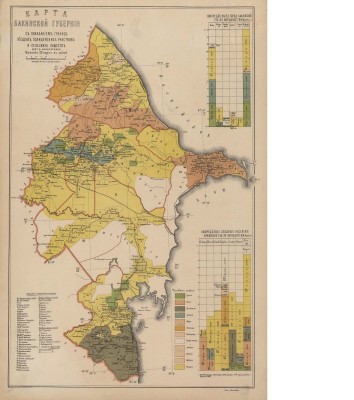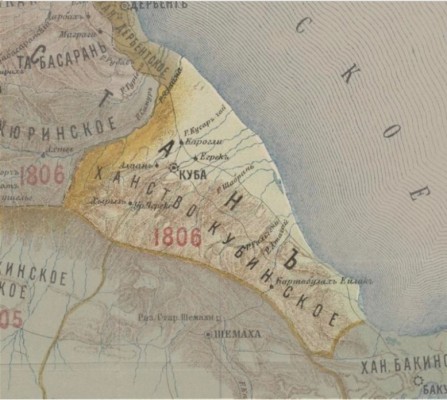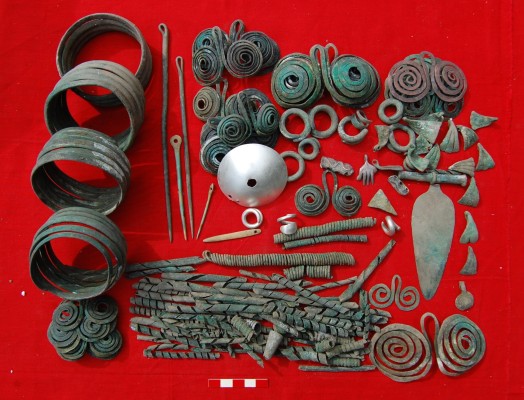The village of Khinalig is known all over the world for the River Gudyalchay, which flows along the mountain slopes, its glorious beauty distinguished among the steep cliffs. The area above Khinalig is covered with glaciers almost all year round.
The village is surrounded by a series of depressions and plateaus, such as the Shahduzu depression, Shahdag and Gizilgaya plateaux, and the highest peaks in Azerbaijan above 3500-4000 meter, including Khinalig, Bazarduzu, Tufandag, Shahdag and Gizilgaya. Khinalig also boasts over 5,000 years of history. Although the village is nestled on a steep mountain peak with a harsh climate, which makes it extremely difficult for living, the people of Khinalig have managed to adapt to the land and use the limited natural resources with prudence. The climate in this area does not support the growth of trees, but it is conducive to most cold-enduring varieties. As in other mountainous areas, the climate in the area where the village of Khinalig is located varies according to altitude.
High mountain areas (>2,700 m) are characterized by upland cold desert climate, while in lower territories (1,500-2,700 m) cold winter climate with abundant precipitation is dominant.
The annual temperature is 6°C, and the yearly precipitation is 575 mm in Khinalig. The maximal daily precipitation is 56 mm. Most of the rain falls in spring, summer, and autumn. The midsummer and winter months are relatively dry. In winter, precipitation falls and accumulates mainly in the form of snow. Melting of snow begins in mid-March, increasing the water in the mountain streams. Floods are common during warm seasons. Intensive foraging can be accompanied by rain, increasing the peak and duration of floods.
Around the village, there are many springs and more than ten caves. These caves are mainly composed of lawn breccia karsts. These are sedimentary breccia that consists of shattered fragments of minerals or rock cemented together by a fine-grained matrix. Common features of all the caves include smooth floors and indented ceilings, as well as visible traces of water. Water entering the cave from outside, mainly from above, gradually accumulates on the floor of the caves to form small pools, which only flows out once the pools are full. As a result, a certain amount of water accumulates in small pools and stays for some period.
Although there are only a few landscape types in and around the village of Khinalig, since it is located in a high mountainous area, vertical zoning is clearly visible. Alpine and subalpine meadows are widespread in the areas close to Khinalig and are the main habitats in its ecosystem. These meadows are spread both above and below the village, mainly at altitudes of 1,800-3,200 m. The mountain meadow ecosystem in the area contains mainly subalpine and alpine plants.
Into enchanting forests
There is a forested area close to the yaylag area (summer pastures), not far from the village of Khinalig at an altitude of 2,300 metres, which is a rare phenomenon for this subalpine zone. This area is called Mugoz and considered sacred by the Khinalig people. The locals protect this small forest fragment, where felling trees is taboo for the community members. They agree that the forest fragment must be protected permanently, and there are even some religious beliefs surrounding the issue. Similarly, hunting of the surrounding area’s East Caucasian tur (Capra cylindricornis) and Caucasian snowcock (Tetraogallus caucasicus) is forbidden by the local community.
Wander into the wild
The wildlife near the village of Khinalig is rich, consisting of many valuable species. East Caucasian tur (Capra cylindricornis), Caucasian chamois (Rupicapra rupicapra subsp. Caucasica), Bezoar ibex (Capra aegagrus aegagrus), mountain goat (Capra aegagrus hircus), lynx, brown bear and wild boar (Susscrofa), as well as different types of falcons and eagles, which live in this area, are protected by the state. The Khinalig people also have certain spiritual beliefs regarding some of the animals and birds that inhabit the areas. The locals are respectful towards nature, by taking and giving back is balanced in a way that is always sustainable. Various taboos on hunting certain animals (like Caucasian snowcocks) and felling trees, which are rare at that altitude, are interesting phenomena developed throughout centuries to protect the surrounding nature through beliefs.
Land of rushing rivers
Near the village of Khinalig flow the rivers Gudyalchay, Khinaligchay and Michek. The first two are abundant, while the latter dries up in the summer months. All rivers are fed by snow and rainwater and partly by groundwater. River Gudyalchay has as a very large riverbed, with many ditches that irrigate the meadows of Khinalig village, which are located near the riverbed. The Gudyalchay and Gusarchay rivers flow through glacial U-shaped trough valleys in their upper reaches and flow through box-shaped gorges with steep slopes in the middle reaches. The total length of the Gudyalchay canyon is 13 km. In the evenings, this canyon becomes a place of mysticism and wonder as low clouds rush in and shroud the landscape in mist.
Versatile plants
The use of wild plant species is significant in the lifestyle of the Khinalig people, who use yaylags and gishlags for the seasonal movements. Many plants in these areas have been used not only in local cuisine and for household items, but also as medicinal plants. The wild plants’ growing season, distribution and use, both in the household and for medical purposes, all hold an important place in the traditional knowledge of the Khinalig people, which is widely applied even to this day. In most cases, these plants are taken directly from nature.
Partly protected by Shahdag National Park, the high mountain areas around the village of Khinalig, perched picturesquely in the Greater Caucasus Mountains, are ideal to see the best of the region’s birds, including endemics to the Caucasus region. Previously too remote for many tourists,
improvements in access have now put Khinalig firmly on the tourist map of Azerbaijan as one of its unmissable sights. The sparsely vegetated mountainous
terrain surrounding it is a great place to look for the Caucasian snowcock, Guldenstadt´s redstart, alpine accentor, rock thrush and lammergeier (or
‘bearded vulture’).
Target species
Alpine accentor (Prunella collaris)
Caucasian snowcock (Tetraogallus caucasicus)
Green warbler (Phylloscopus nitidus)
Guldenstadt’s redstart (Phoenicurus erythrogastrus)
Lammergeier (Gypaetus barbatus)
Wallcreeper (Tichodroma muraria)
Red-fronted serin (Serinus pusillus)
Rock thrush (Monticola saxatilis)

.jpg)
.jpg)
.jpg)


